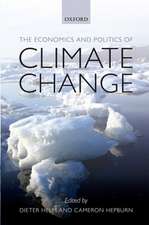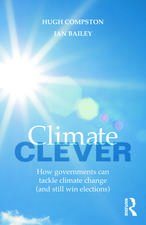Climate Change Modelling, Planning and Policy for Agriculture
Editat de Anil Kumar Singh, Jagdish Chander Dagar, Ayyanadar Arunachalam, Gopichandran R, Kirit Nanubhai Shelaten Limba Engleză Hardback – 30 mar 2015
| Toate formatele și edițiile | Preț | Express |
|---|---|---|
| Paperback (1) | 563.66 lei 39-44 zile | |
| Springer India – 12 oct 2016 | 563.66 lei 39-44 zile | |
| Hardback (1) | 649.71 lei 6-8 săpt. | |
| Springer India – 30 mar 2015 | 649.71 lei 6-8 săpt. |
Preț: 649.71 lei
Preț vechi: 764.37 lei
-15% Nou
Puncte Express: 975
Preț estimativ în valută:
124.33€ • 132.94$ • 103.66£
124.33€ • 132.94$ • 103.66£
Carte tipărită la comandă
Livrare economică 17 aprilie-01 mai
Preluare comenzi: 021 569.72.76
Specificații
ISBN-13: 9788132221562
ISBN-10: 8132221567
Pagini: 280
Ilustrații: XVII, 245 p. 123 illus., 103 illus. in color.
Dimensiuni: 178 x 254 x 18 mm
Greutate: 0.68 kg
Ediția:2015
Editura: Springer India
Colecția Springer
Locul publicării:New Delhi, India
ISBN-10: 8132221567
Pagini: 280
Ilustrații: XVII, 245 p. 123 illus., 103 illus. in color.
Dimensiuni: 178 x 254 x 18 mm
Greutate: 0.68 kg
Ediția:2015
Editura: Springer India
Colecția Springer
Locul publicării:New Delhi, India
Public țintă
ResearchCuprins
1. Climate change: Adaptation and mitigation strategies in rainfed agriculture.- 2. Diversification of Agriculture in India: Challenges Ahead.- 3. Changes in the synoptic disturbances and its impact on extreme rainfall indices in India.- 4. Meteorological drought analysis based on rainfall data of coastal Odisha.- 5. Climate change impacts on rainfed soybean yield of central India: Management strategies through simulation modeling.- 6. Application of CERES-wheat model for wheat yield predication for climatic variability of different agro-climatic zone in India.- 7. Multispectral remote sensing to distinguish the little seed canary grass (Phalaris minor) from wheat crop under field conditions for environmental sustainability and precision weed management.- 8. Modeling of weather parameters using stochastic methods.- 9. Geospatial methodology towards planning adaptation/ mitigation measures of climate change impact on the apple orchards in India.- 10. Utilization of open sourceweb-GIS to strengthen climate change informatics for agriculture.- 11. Design and development of rubber dams for watersheds in the climate change scenario.- 12. Impact of climatic variability on crop production in Mahanadi delta region of Odisha.- 13. Role of ICT’s in sustainable agriculture: A study of e-sagu in Andhra Pradesh.- 14. Carbon Sequestration in Grassland Ecosystems of Salt-Affected Soils in Northern India.- 15. Community leadership to achieve climate resilient agriculture: A bottom-up approach to strengthen India’s missions.- 16. Climate change and Indian agriculture: Impacts, solutions and adaptation.- 17. Climate Change and Hill Agriculture in North West Himalaya.- 18. Climate Change and Mitigation Options for Sustainable Agriculture in Rajasthan.- 19. Trends in Climatic Change in Last Fifty Years at Seven Agro-Climatic Regions of Tamil Nadu.- 20. The Effect of Changing Climate and Land Use/Land Cover on Water Resources in Hard Rock Region of Maharashtra State.- 21. Impact of Climate Change on Water Resources.- 22. Building climate resilient agriculture and enhancing grassroots level adaptive capacity in the semi-arid tropics of India - Indicative Policies for Action.
Recenzii
“This book provides a concurrent consideration ofclimate change with agriculture policies … together with agriculturalsustainability, with emphasis on the significance climate change to a rain-fedagriculture. … this book offers an integrated, qualitative, and comprehensiveanalysis of the capacity of agriculture to respond to environmental changes,and will be the great interest for soil and plant scientists and researchers,policy makers, and forest officials.” (Vijay Singh Meena, Journal of CleanerProduction, Vol. 102, September, 2015)
Notă biografică
Dr. Anil Kumar Singh is currently the Vice-Chancellor of the Rajmata Vijayaraje Scindia Krishi VishwaVidyalaya, Gwalior. Earlier he was the Deputy Director General (NRM) in ICAR—2007-2012; Acting Director, IARI-2005-2006; Project Director, Water Technology Centre-1999-2007. Dr. Singh joined the Agricultural Research Service in 1976 and grew up to Principal Scientist until 1999. His areas of research interest have been soil-water-nutrient-plant-atmosphere interactions, crop growth simulation, irrigation water management, and integrated watershed management. Dr. Singh has been known as a DAAD Fellow at University of Hohenheim, Germany and has served in International Rice Research Institute between 1993 and 1995.
Dr. Jagdish Chander Dagar has been well recognized for his research in the area of agroforestry, both nationally and internationally. He is presently working as Scientist Emeritus in Central Soil Salinity Research Institute, Karnal; previously Dr. Dagar wasthe Assistant Director General (Agronomy/Agroforestry) at the headquarters of ICAR (2010-2012). His research interest has been in the areas of biosaline agriculture, agroforestry, rehabilitation of degraded lands, management of natural resources, bio-drainage, climate change, and sustainable agriculture and policy. He has written several books and has published more than 200 research papers of high repute in international and national level journals.
Dr. A. Arunachalam is a trained ecologist from the North-Eastern Hill University, Shillong and has grown professionally through strong pursuit in ecological research that is evident from his 150 research papers, 5 synthesis volumes, 100 book chapters and 25 popular articles. He started his service as a Lecturer/Assistant Professor in Forestry, North Eastern Regional Institute of Science & Technology (Arunachal Pradesh) and currently he is working as a Principal Scientist in the headquarters of Indian Council of Agricultural Research, Krishi Bhawan, New Delhi. His areas of research has been - Restoration Ecology & Environmental Management (Ecosystems; Forest Ecology & Management; Agriculture & Soil Nutrient Management and Conservation Biology.
Dr R Gopichandran serves as the Director of Vigyan Prasar, an autonomous institution of the Department of Science & Technology, Government of India. His two doctoral degrees are in the areas of microbial ecology and chemical ecology. He holds a degree in law. A significant part of his career that has spanned nearly twenty five years till now was spent on chemicals management for ozone layer protection. His insights on substitution, phase out and integrated management of ozone depletion and climate protection including inclusive mitigation and adaptation approaches were derived through strong working links with the Compliance Assistance Programme of the OzonAction programme, United Nations Environment Programme, at the regional levels.This was predominantly as part of his output at the Centre for Environment Education, Ahmedabad and the Gujarat Energy Research & Management Institute, Gandhinagar.
Dr. Kirit Nanubhai Shelat was a public administrator for the Government of Gujarat, India. He is currently associated with NGOs and Trusts. Dr. Kirit Nanubhai Shelat is Ph.D in Public Administration. He recently retired from the Indian Administrative Service. He started his career in public administration by joining the Gujarat Administrative Service in the year 1967. During his career of 40 years, he has worked at the grass-root level and had his hand in the formulation and implementation of policies for Agricultural, rural and Industrial development. He has worked as Commissioner of Rural Development, Industries Commissioner, Commissioner for Employment and Training, Commissioner for disabled persons and Secretary Energy Department. He has also worked, as Chairman of State Level Public undertaking likeGujarat Agro Industries Corporation, Land Development Corporation. He also worked in Afghanistan as Land Settlement Advisor to Government of Afghanistan. He has designed and implemented large-scale projects for poor families, farmers, and micro entrepreneurs. He developed guidelines for Micro-level planning with focus on individual poor family and village development plan. He was responsible for “Cluster development approach” for small industries and “Step up project” for rural micro level Entrepreneurs. He developed micro level production plan module for individual farmer and has his hand in restructuring the Gujarat agriculture sector. He introduced new extension approach of meeting with farmers at their door step prior to monsoon by team led by agriculture scientist. He introduced scientific agriculture based on soil health moisture analysis giving a soil health card to every farmers of Gujarat. This effort went in a long way in developing sustainable agriculture in Gujarat.
Dr. Jagdish Chander Dagar has been well recognized for his research in the area of agroforestry, both nationally and internationally. He is presently working as Scientist Emeritus in Central Soil Salinity Research Institute, Karnal; previously Dr. Dagar wasthe Assistant Director General (Agronomy/Agroforestry) at the headquarters of ICAR (2010-2012). His research interest has been in the areas of biosaline agriculture, agroforestry, rehabilitation of degraded lands, management of natural resources, bio-drainage, climate change, and sustainable agriculture and policy. He has written several books and has published more than 200 research papers of high repute in international and national level journals.
Dr. A. Arunachalam is a trained ecologist from the North-Eastern Hill University, Shillong and has grown professionally through strong pursuit in ecological research that is evident from his 150 research papers, 5 synthesis volumes, 100 book chapters and 25 popular articles. He started his service as a Lecturer/Assistant Professor in Forestry, North Eastern Regional Institute of Science & Technology (Arunachal Pradesh) and currently he is working as a Principal Scientist in the headquarters of Indian Council of Agricultural Research, Krishi Bhawan, New Delhi. His areas of research has been - Restoration Ecology & Environmental Management (Ecosystems; Forest Ecology & Management; Agriculture & Soil Nutrient Management and Conservation Biology.
Dr R Gopichandran serves as the Director of Vigyan Prasar, an autonomous institution of the Department of Science & Technology, Government of India. His two doctoral degrees are in the areas of microbial ecology and chemical ecology. He holds a degree in law. A significant part of his career that has spanned nearly twenty five years till now was spent on chemicals management for ozone layer protection. His insights on substitution, phase out and integrated management of ozone depletion and climate protection including inclusive mitigation and adaptation approaches were derived through strong working links with the Compliance Assistance Programme of the OzonAction programme, United Nations Environment Programme, at the regional levels.This was predominantly as part of his output at the Centre for Environment Education, Ahmedabad and the Gujarat Energy Research & Management Institute, Gandhinagar.
Dr. Kirit Nanubhai Shelat was a public administrator for the Government of Gujarat, India. He is currently associated with NGOs and Trusts. Dr. Kirit Nanubhai Shelat is Ph.D in Public Administration. He recently retired from the Indian Administrative Service. He started his career in public administration by joining the Gujarat Administrative Service in the year 1967. During his career of 40 years, he has worked at the grass-root level and had his hand in the formulation and implementation of policies for Agricultural, rural and Industrial development. He has worked as Commissioner of Rural Development, Industries Commissioner, Commissioner for Employment and Training, Commissioner for disabled persons and Secretary Energy Department. He has also worked, as Chairman of State Level Public undertaking likeGujarat Agro Industries Corporation, Land Development Corporation. He also worked in Afghanistan as Land Settlement Advisor to Government of Afghanistan. He has designed and implemented large-scale projects for poor families, farmers, and micro entrepreneurs. He developed guidelines for Micro-level planning with focus on individual poor family and village development plan. He was responsible for “Cluster development approach” for small industries and “Step up project” for rural micro level Entrepreneurs. He developed micro level production plan module for individual farmer and has his hand in restructuring the Gujarat agriculture sector. He introduced new extension approach of meeting with farmers at their door step prior to monsoon by team led by agriculture scientist. He introduced scientific agriculture based on soil health moisture analysis giving a soil health card to every farmers of Gujarat. This effort went in a long way in developing sustainable agriculture in Gujarat.
Textul de pe ultima copertă
It is well known that the impacts of climate change are tangible and hence there can be no debate about the need for appropriate adaptation measures, on a priority basis. However, it is equally important to recognize the fact that adaptation measures actually represent a dynamic synthesis of interventions pertaining to multiple systems. These are particularly of water, soil characteristics, genotypic and phenotypic variations and their expressions, age-correlated biochemical changes aligned with planting schedules and favorable weather/climate conditions. Nutrients, occurrence and distribution of associated vegetation including crop mixes also influence productivity. The overarching aspect of farming practice wields significant influence on the outcome and hence it is important to be clear about the particular focus of the investigations being carried out and reported in a suitable manner. It is essential to recognize that scientific research in agriculture in India has always produced valuable results of direct relevance to her people. Importantly, preparedness to tackle disasters due to inclement weather system has prominently featured on the agenda. The recent focus on climate change and impacts has provided the necessary impetus to reorganize the framework of investigation to capture the specifics of such impacts. In this context, the importance of micro climate variations too viz-a-viz the larger scales of impacts cannot be overemphasized. It will be useful to also help characterize natural variations versus artificially induced variations, helping us understand the complexities of individual and synergistic impacts too. Obviously, the limits and limitations of models could determine the spread and depth of the outcomes of investigations. Empirical evidences to reinforce assumptions have to also be documented with utmost care; guided by an understanding of the limits of tolerance, limiting factors, and the precautionary principle especially in the public policy interface. The present volume therefore, showcases these strands with the fond hope that they will stimulate further thinking and enable appropriate action.
Caracteristici
Comprehensively describes climate change predictions Covers comprehensive modeling of climate change impact on agriculture including crops and livestock Includes policy provisions enabling climate resilience in agriculture and environmental sustainability


















